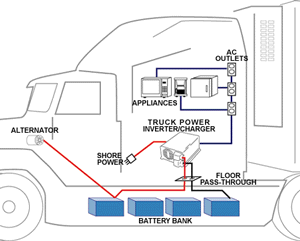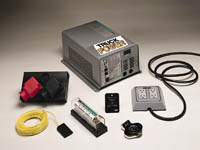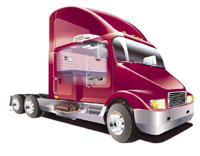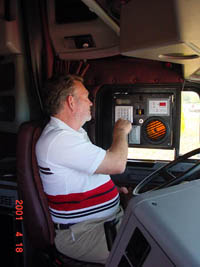A Truck and inverter success stories,
Roadway Trucks, truck power, truck inverters, chargers, inverters for longhaul
truck, AC power for trucks, TRUCKPOWER.
Plug It In
Truck Stop Electrification Gaining Momentum
By Tom Kelley
At first glance, the concept of Truck Stop Electrification (TSE) may seem like a
nice convenience for truckers and a good way to sell a few more AC appliances
for trucks, but there is a much loftier goal involved here. As environmental
regulations are tightened, the industry needs to find ways to reduce its total
output of air pollutants. According to numerous studies, typical overnight
idling practices contribute approximately 40 million tons of exhaust emissions
to the environment each year. Letting trucks plug in, instead of idling, would
have a significant positive impact on the environment.
Although the environmental aspect on its own may be a tough sell, there's also a
significant economic benefit that will likely be the driving force behind TSE.
According to a studies by the Edison Electric Institute and the Argonne National
Laboratory, idling an engine for 2,500 hours annually is the equivalent of
200,000 extra miles of engine wear, burning 3,750 gallons of diesel fuel, and
adding operation costs between $4,000.00 and $7,000.00 per truck per year.
 |
|
An inverter/charger system
equipped to take advantage of shore power connections will allow standard
110V AC appliances to be powered from either the truck's electrical system
or an electrified trucks top.
|
Broken down to a per-hour cost, engine idling costs
approximately $2.75 per hour. Even at a plug-in rate of $1.00 per hour, the cost
to upgrade or equip a truck would generally be recovered in the first year. On
the other side of the equation, it's also a quick payback for the truck stop or
service provider.
To realize the benefits of TSE, trucks would ideally be equipped with a DC/AC
inverter connected to the truck's batteries and charging system to allow use of
the AC appliances while en route or for short durations while parked. For longer
duration overnight stops, the truck would be plugged into the local electric
utility, similar to existing arrangements at RV parks and boat marinas.
When the trucking industry first gave serious consideration to TSE a few years
ago, the process was caught in proverbial "chicken or the egg" conundrum. The
problem was apparent and the solution was available, but it was unclear as to
"what comes first." Should truck stops install the hardware when it will reduce
their fuel sales? Should truckers demand the service from truck stops? Should
the OEMs add AC shore power systems to trucks before the truck stop
infrastructure is in place? Should the utility company step in to develop the
market or should third parties take the lead?
In just a few short years, here is what has happened:
Many truck stops now have AC power connections available. Some of these
connections have been installed by the truck stop operators and some have been
installed by third-party services such as Park-N-View.

Inverter/charger systems such as this unit from Xantrex are available as a
factory option from virtually every tractor OEM.
|
IdleAire of Knoxville, TN is currently performing field
trials of a truck stop-based system that will not only deliver AC power to the
truck cab, but off-board heating and air conditioning as well. According to
IdleAire executive vice president Tom Budget, the system should begin commercial
deployment in mid summer.
George Strickland from Travel Centers of America reports
that his company's test site in Willington, CT has seen minimal use, but that
this is primarily because the service has not been actively marketed yet.
According to Strickland, TSE is still dependent on three factors each gaining
critical mass: a larger market for the service, development of the system to
handle the actual sale of the power, and finally, equipment and technology that
will allow the service to be consistent throughout his (or any other vendor's)
locations. "Through our fleet group, we talk with the top 100 trucking
organizations routinely and meet with them at least annually. We need them to
say that they're electrifying their trucks and need places to plug in," said
Strickland.
Not content to rely entirely on the truck stops, many fleets are electrifying
the parking areas at their terminals to realize additional savings from idle
reduction.
Truck fleets and owner-operators continue to increase the demand for "Shore
Power" systems from the tractor OEMs. Volvo reports that roughly 90% of the 770
model tractors sold in the last few years are equipped for shore power. For
those not quite ready to take the full plunge, Volvo also offers a pre-wire
option that permits the equipment to be added later without retrofitting any
wiring. Xantrex, a company that represents the consolidation of several top
names in the inverter business, offers a complete shore power kit for factory or
aftermarket installation. Virtually every truck OEM now has some form of shore
power offering available as an option.
Long known for its RV air conditioning systems, the Domestic Corp.'s has
established its Cab Comfort division to develop and market AC powered heating
and air conditioning systems for truck sleepers. In addition to being able to
run on shore power, the Cab Comfort system can also be powered by Domestic's
Kwyatt Power self-contained battery pack and inverter system while en-route or
away from the "grid."
Utilities and municipalities are beginning to take an interest in TSE for the
potential benefits of helping to meet emission regulations. "Clean air" cities
can potentially help offset the cost to electrify truck stops and put AC
infrastructure into trucks, thanks to emission reduction credits. Basically,
utilities document the reduction in emissions and then can use those emissions
to offset, for example, the pollution a new power plant produces. Last year, the
credits topped out at $40 for 1 pound of NOx. A truck idles 9/10ths of a pound
per hour!!
As the representative of many U.S. utility companies, the Edison Electric
Institute (EEI) is planning to lobby in favor of TSE incentives at the federal
level. According to the EEI's Rick Tempchin, " to deploy TSE on a large-scale
basis, a coalition effort of all participants in the process will be necessary."
And finally, until TSE becomes widely deployed, many alternatives to idling are
available. On-board temperature and battery control systems such as those from
Temp-A-Start and Webasto are designed to tie in with existing fuel and
electrical systems to minimize the need for idling and protect battery voltage
for starting requirements.
With the obvious environmental benefits, the local, state, and federal
governments should step up to the plate and provide some incentives for
developing the necessary infrastructure. Any further emission systems added to
trucks are likely to come at great cost and with only a minuscule incremental
reduction in emissions. TSE represents an opportunity to drastically reduce
emissions industry-wide, on both new trucks and old alike.
Billions of dollars have been spent on nearly-empty HOV lanes around the
country, all in the interest of shutting off a few cars for a few hours of
commuting, five days a week. Although TSE wouldn't require the same outright
"handout" received by the questionably-worthwhile HOV projects, tax credits or
incentives for those implementing TSE would most likely get the ball rolling and
result in thousands of truck engines being shut off for 8-10 hours per day,
seven days a week.
Idle Reduction Work Sheet
A truck that idles 6 hours a night for a 5 day work week translates to 6
months of continuous idling, over 3 years. The amount of fuel consumed?
Approximately 4,680 gallons. Cost at $1.50 per gallon. $7,020. NOx emitted?
4,212 pounds.
|
The following table summarizes the cumulative reduction in idle time for a 12
week, 12, 24 and 36 month periods based on the elimination of various hours of
idle time per night.
| Reduction/Day |
Hours/Week |
12 weeks |
1 Year |
2 Years |
3 Years
|
| 4 hours |
20 hours |
240 hours |
1040 hours |
2080 hours |
3120 hours
|
| 6 hours |
30 hours |
360 hours |
1560 hours |
3120 hours |
4680 hours
|
| 8 hours |
40 hours |
480 hours |
2080 hours |
4160 hours |
6240 hours
|
Fuel Savings:
The table below demonstrates the fuel cost for one truck that idles for
various hours in a day for a 5 day work week over a 3, 12, 24 and 36 month
period.
| Hrs./Day |
Price/Gal |
Hrs./Gal. |
Cost/Day |
12 weeks |
1 Year |
2 Years |
3 Years
|
| 4hrs. |
$1.50 |
1 |
$6.00 |
$360.00 |
$1,560 |
$3,120 |
$4,680
|
| 6hrs. |
$1.50 |
1 |
$9.00 |
$540.00 |
$2,340 |
$4,680 |
$7,020
|
| 8hrs. |
$1.50 |
1 |
$12.00 |
$720.00 |
$3,120 |
$6,240 |
$9360
|
Battery savings
The regular use of the built-in 3-stage temperature compensated battery
charger, which activates automatically when a driver connects to shore power,
will increase battery life. Based on the assumption that you replace truck
batteries at the industry average of every 12 months, the projected cost savings
are demonstrated in the table below.
| No. of Batteries |
Price/Battery |
12 weeks |
1 Year |
2 Years |
3 Years |
| 3 |
$65.00 |
$48.75 |
$195 |
$390 |
$585 |
| 4 |
$65.00 |
$65.00 |
$260 |
$520 |
$780 |

Domestic's Cab Comfort heating and air conditioning system can be operated
from shore power or an inverter/charger system.
|
Engine Maintenance
The reduction of engine idling will extend engine service intervals and
result in a decrease in engine maintenance costs. The following is a partial
list of service items that will be positively affected by a reduction in engine
idling:
- Increased intervals between oil changes
- Increased intervals between coolant changes
- Increased intervals between filter changes
- Decreased engine wear

A fuel-pump style card-reader
and keypad are used to purchase service through the IdleAire system.
|
Other "Real" Benefits (not factored into ROI):
- Higher trade-in value
- Lower time on engine
- Inverter/Charger and HVAC system will return a
premium
- Driver recruitment and retention tool
- Lower food cost (less meals at restaurants) is like a
pay raise for drivers
- Reduction in exhaust emissions may result in
government rebates or at a minimum goodwill from the community
Fixed Costs:
The cost of the Inverter/Charger system, installed is: $1,600
The cost of the installed AC-powered HVAC system is:
$1,200
Total system cost = $2,800
Variable Costs National Average for Electricity:
- 0 amps (diversified load) X 120 volts AC = 1200 watts
- 1kW/hour = 7› therefore 1.2kW/hours = 8.4 cents
Based on the above information the cost for electricity
is:
| Hours/Day |
Cost/Day |
12 weeks |
1 Year |
|
2 Years |
3 Years |
| 4 hours |
34 |
$20.40 |
$88 |
|
$176 |
$264
|
| 6 hours |
50 |
$30 |
$130 |
|
$260 |
$390 |
| 8 hours |
67
|
$40 |
$174 |
|
$348 |
$522
|
Note: Rates for kW/hr vary across the country
from approximately 4 to 13› per kW/hr.
Projected Return on Investment (ROI) per Truck:
| Hours/Day |
1 Year |
2 Years |
3 Years
|
| 4 hours |
($1,240) |
$320 |
$1,880
|
| 6 hours |
($460) |
$1,880 |
$4,220
|
| 8 hours |
$320 |
$3,440 |
$6,560
|
Note: ROI is based on a $2,800 system
purchase and installation and does not include the cost of electricity, nor the
savings in battery purchases (which virtually offset each other).
Projected 3 Year Return on Investment (ROI) for
Fleets:
| Hours/Day |
500 Trucks |
1,000 Trucks |
2,500 Trucks |
5,000 Trucks
|
| 4 hours |
$940,000 |
$1,880,000 |
$4,700,000 |
$9,400,000
|
| 6 hours |
$2,110,000 |
$4,220,000 |
$10,550,000 |
$21,100,000 |
| 8 hours |
$3,280,000 |
$6,560,000 |
$16,400,000 |
$32,800,000 |
| 1,Truck
Inverters/Chargers. At this site you'll find information about long haul
truck power inverters that deliver clean 120 VAC 60 Hz power to run standard
AC equipment from batteries, truck power, truck inverters, chargers,
inverters for longhaul truck, AC power for trucks, TRUCKPOWER ,8 |
![]()